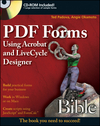It seems that calculating totals in an expandable table with a dynamic/repeatable row is a hot topic lately so I thought I would post a tutorial on how to build a simple table which represents a purchase order where you can add and remove line items and various totals are automatically calculated.
Before we get started, you’ll need Designer 7.1 and Acrobat/Reader 7.0.5 at minimum to run through this tutorial. I will be using Designer 8.2 and Acrobat/Reader 9.0 to do the tutorial so it’s possible some of the UI may have changed slightly since the 7.1/7.05 versions.
Continue reading…
Posted by Stefan Cameron on February 25th, 2009
Filed under
Data Binding,
Designer,
FormCalc,
Scripting,
Tables,
Tutorials,
XFA
The recording of the Acrobat User Community eSeminar on Advanced Forms and LiveCycle Designer by Easel Solution’s Angie Okamoto is now available for viewing. Angie demonstrates advanced concepts in creating dynamic forms with LC Designer and you can also see all of the Q&A comment threads between the attendees and the team of specialists answering the questions.
Posted by Stefan Cameron on February 13th, 2009
Filed under
Data Binding,
Designer,
Instance Manager,
Scripting,
Tables,
Tutorials

Angie Okamoto, Director of Enterprise Development at Easel Solutions, and Ted Padova, the "PDF Guru" and author of the "Adobe Acrobat PDF Bible" series, have published a new book titled, "PDF Forms Using Acrobat and LiveCycle Designer Bible". I’m sure it’ll be a great reference!
Their book is available now on Amazon.com and Wiley.com.
Posted by Stefan Cameron on February 5th, 2009
Filed under
Acrobat,
Books,
Data Binding,
Designer,
Instance Manager,
Scripting,
Tables,
Tutorials,
XFA
This is the first part in a multi-part post series for Adobe MAX 2008 designed to show you how extend a form guide to import data from a website without using FlexBuilder. If you haven’t seen it already, I recommend you have a look at the demo on last Friday’s tutorial preview post to get a sense of what we’re going to be building. In this first part, we will build the form necessary to provide the print/archive capabilities for the Movie Catalog.
Throughout the tutorial, I will assume that you’ve used Designer already and you know about things like flowed vs positioned subforms. I will also assume that you’re familiar with Guide Builder’s interface for designing Form Guides.
Software Requirements
Before we get started, make sure you’re using Designer 8.2.1 SP1 and Guide Builder 8.2.1 SP1. You can download an evaluation version of Designer and Guide Builder when you download the Acrobat 9.0 Pro trial. If you haven’t installed SP1 yet, you can download it from here (note that you only need to install the Designer SP1 update — you don’t need Workbench or even LiveCycle ES to run through this tutorial).
If you already have Designer but you don’t have Acrobat, you can use Reader 9.0 to go through the tutorial.
Continue reading…
Posted by Stefan Cameron on November 17th, 2008
Filed under
Conferences,
Data Binding,
Designer,
Scripting,
Tables,
Tutorials,
XFA
In the past, I’ve written a lot of articles on submitting data to databases and web services but there’s another way to submit form data: via HTTP POST. In this scenario, you use a regular button object configured to submit to a web page via HTTP or you just use the HTTP submit button object and set the URL appropriately.
Steve, a colleague of mine who works on LiveCycle Designer ES, wrote two posts about this technique a while back. I’ve frequently referred to it in my replies to your comments on various posts so I thought I would include the links in a more prominent place so they’re easier to find:
- The original HTTP Submit post.
- An important update to the original post.
One use of this could be to make submitting data to a database more secure* than exposing the database on the Internet (which is seldom a good idea). For example, you could have your form’s data posted to a PHP page which could then relay it into a MySQL database running behind the scenes. Another popular combination is ASP and Microsoft Access databases.
* Please note that I cannot speak to the level of security of said suggestion/solution. I’m merely suggesting it could be more secure.
Posted by Stefan Cameron on September 15th, 2008
Filed under
Bugs,
Data Binding,
Designer,
Tutorials

